
American Chestnut - Killed by Blight
The American chestnut tree survived all adversaries for 40 million years, then disappeared within 40. More than a century ago, nearly 4 billion American chestnut trees were growing in the eastern U.S. They were among the largest, tallest, and fastest-growing trees. The wood was rot-resistant, straight-grained, and suitable for furniture, fencing, and building. The nuts fed billions of birds and animals. It was almost a perfect tree, that is, until a blight fungus killed it more than a century ago. The chestnut blight has been called the greatest ecological disaster to strike the world’s forests in all of history.

American hornbeam (Musclewood)
American hornbeam is a tall shrub or small tree, to 35 feet tall, with overhanging branches and a gray trunk that has musclelike ridges. Leaves are 1-2 inches wide and 2-5 inches long. The upper surface is bluish-green and the undersurface is paler with hair. It flowers from April to May. The fruit hangs in clusters.

Carpinus caroliniana
Artificial Shade Garden
While these solar panels provide free energy for our property, we learned that they can also provide shade for wildlife. It is common to see rabbits, birds or squirrels resting underneath to escape the hot summer sun.
Artificial Wetlands
While these solar panels provide free energy for our property, we learned that they can also provide shade for wildlife. It is common to see rabbits, birds or squirrels resting underneath to escape the hot summer sun.
Beach Plum
Beach plum is a flowering multi-stemmed shrub which typically grows in a low spreading manner to form dense thickets, 3-8 foot tall. A United States’ native found along the Atlantic Coast it is tolerant of coastal salt spray and saline soils. Clusters of small white flowers bloom in spring (April-May), followed by small, purplish-blue fruit that ripens in late summer. The white of the flowers develops a pinkish hue upon successful pollination usually achieved through the service of wild bees, but other pollinating insects may perform the task. The deciduous (sheds their leaves) shrub has egg-shaped leaves. The simple, dark green glossy leaves are velvety or hairy on the underside at maturity. Their attractive fall foliage extends seasonal color. The fruit is popular for jams, jellies, and pies.
Prunus maritima
Bear Oak or Scrub Oak
Commonly known as bear oak or scrub oak, this is a small shrubby oak native to the eastern United States and southeastern Canada. Its range extends in the United States from Maine to North Carolina. It is a deciduous tree or shrub and can grow up to 20 feet high. It has egg-shaped acorns with a saucer-shaped cap.
Quercus ilicifolia provides food and shelter for many animal species. Bears or white-tailed deer eat the acorns and the stems and foliage. Many types of squirrels cache the acorns. Many birds depend on them; wild turkeys prefer them over other types of food. A large number of insect species live on the oak.
Quercus ilicifolia
Bigtooth Aspen
Bigtooth Aspen is a native deciduous tree, which grows throughout northeastern North America. It is also known as Largetooth Aspen, Poplar, or Popple. It is a member of the Willow family. A fast-growing, but short-lived, Bigtooth Aspen attains heights of 60 to 80 feet.
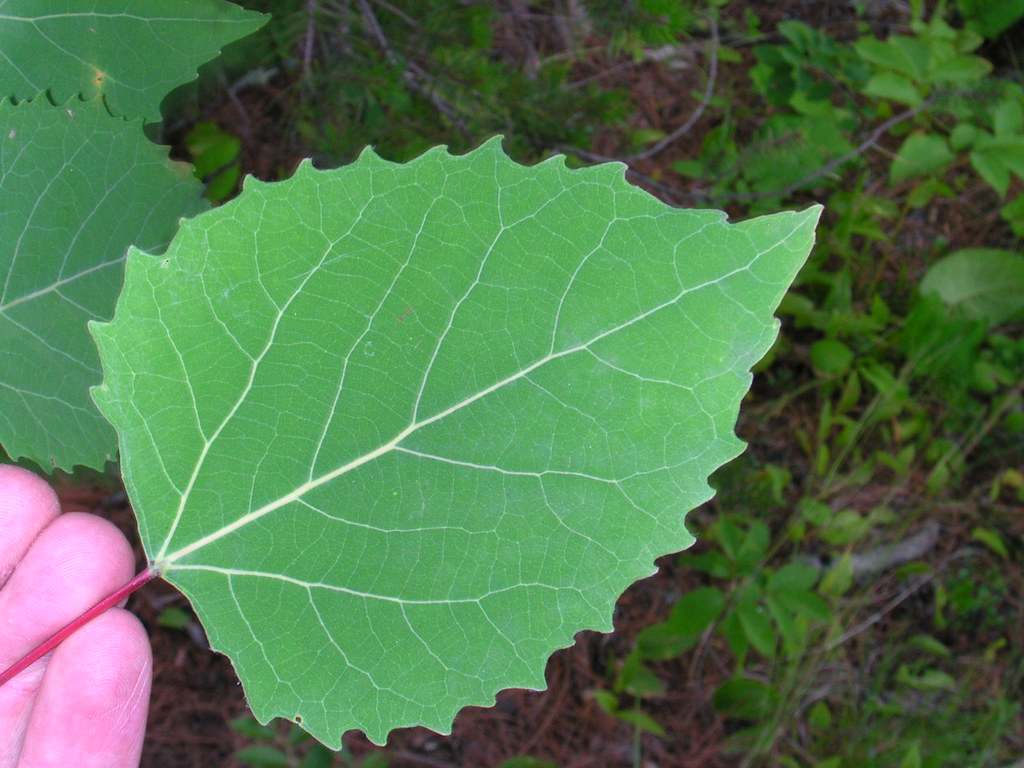
Populus grandidentata
Black Cherry
Black Cherry is a medium-large, wildlife-friendly, flowering shade tree. White flowers bloom in May, followed by small, edible berries. The fruit changes from red to black as it ripens in August-September. It is used for making wine and jelly. Fall foliage is yellow-red. Black Cherry offers much value for birds, butterflies, bees, and wildlife. It is a host plant for butterfly and moth larvae.
Prunus serotina is a medium-sized, fast-growing forest tree growing to a height of 50–80 feet. The leaves are 2–5inches long, ovate-lanceolate in shape, with finely toothed margins.
A mature black cherry tree can easily be identified in a forest by its very broken, dark grey to black bark, which has the appearance of very thick, burnt cornflakes. However, for about the first decade or so of its life, the bark is thin, smooth, and banded, resembling that of a birch. It can also quickly be identified by its long, shiny leaves or by an almond-like odor released when a young twig is scratched and held close to the nose.
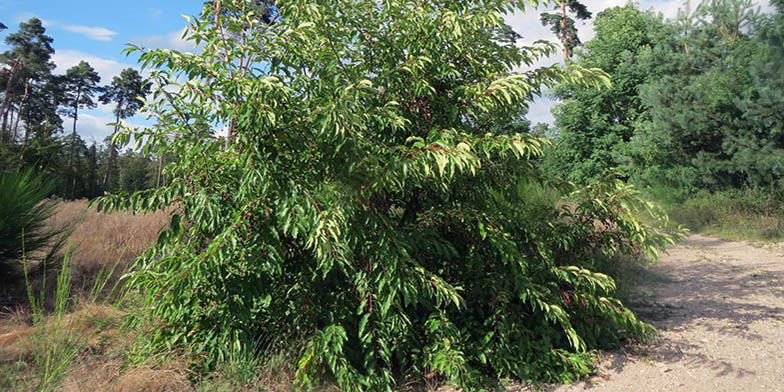
Prunus serotine
Chestnut Oak
The chestnut oak is native to the eastern United States where it is one of the most important ridgetop trees from southern Maine southwest to central Mississippi. It is also known for its beautiful silvery-white bark. The chestnut oak is used as a shade tree for large areas. It prefers full sun and dry, well-drained soil. It is a rapidly growing tree and can attain a height of 60 to 70 feet with a similar spread.

Quercus prinus
Clethra (Summersweet)
Coastal sweet-pepper or summersweet is a deciduous (leaf shedding) shrub, which often spreads into mounded clumps. It is a tall (6-12 feet), many-branched, a leafy shrub with spike-like, upright clusters of fragrant white flowers. These flowers tend to appear around late summer and early autumn. The leaves turn dull yellow to orange in fall.
This shrub forms sizable patches and is remarkably free of any disease, insect, or physiological problems. Its dry fruiting capsules remain long after flowering and help identify this plant in winter.
Clethra grows in humus-rich, moist, well-drained, lime-free soil in shade. It can also grow in the shelter of an open woodland garden or a lightly-shaded shrub border.
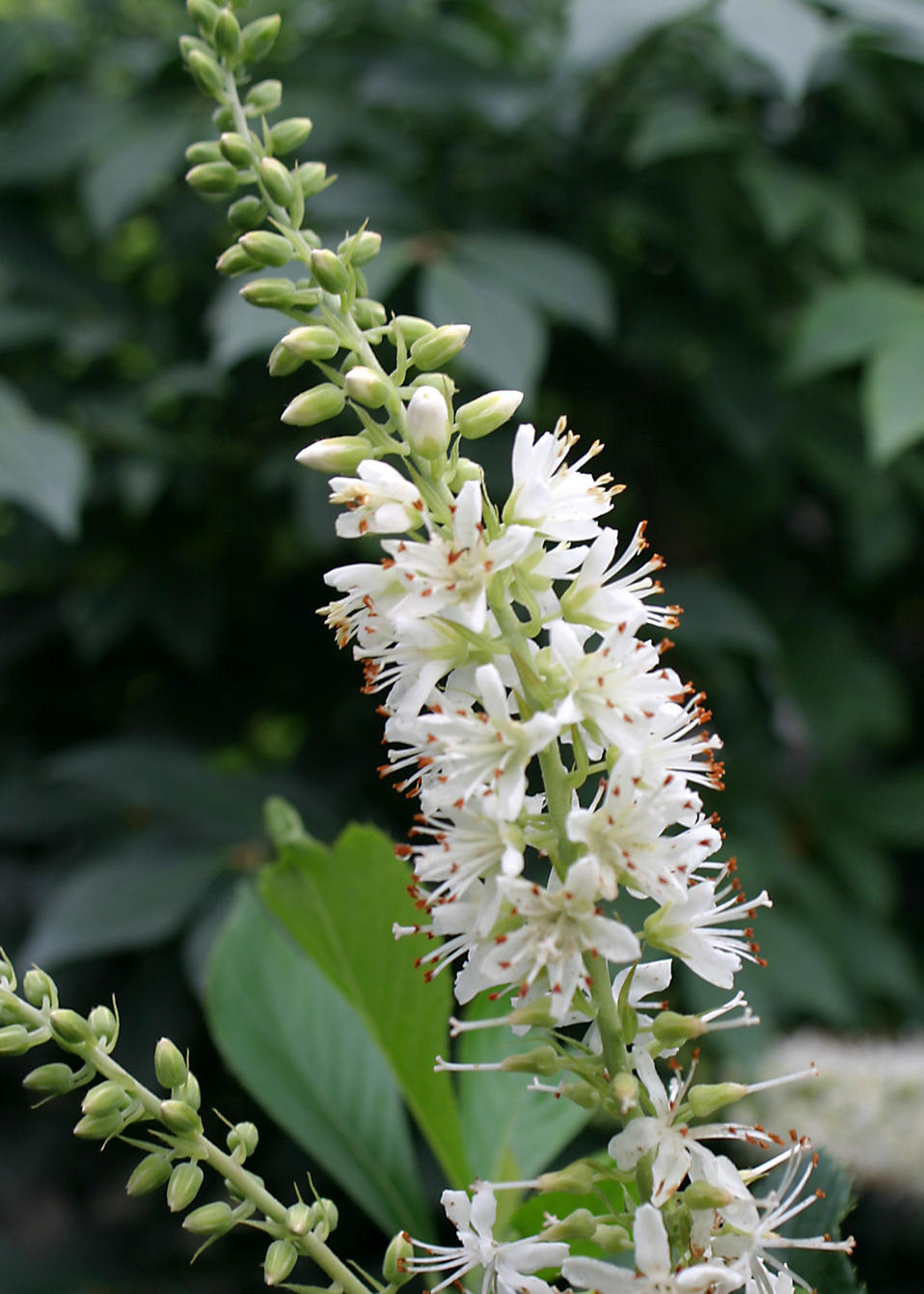
Clethra alnifolia
Eastern Redbud
Cercis canadensis, the eastern redbud, is a large deciduous (leaf shedding) shrub or small tree, native to eastern North America from southern Ontario, south to northern Florida but which can thrive as far west as California. It is the state tree of Oklahoma. It grows 15-30 feet high.
It’s a tree with a short trunk, rounded crown of spreading branches, and pink flowers that cover the twigs in spring. Its pink flowers, borne in tight clusters along the stems and branches before new leaves appear, create a showy spring display. The foliage is not very showy in the fall.
Effects of Defoliation by Gypsy Moth
In the caterpillar stage, gypsy moths cause all the damage. After hatching, the caterpillars may feed for up to two months on the leaves of trees. As they mature, they expand their diet (and their big appetite) and will ultimately continue to feed on trees and shrubs. The leaves of most oak species are their preferred food source, and populations won’t build up in areas that don’t have a reasonable oak tree population.
Heavy defoliation causes stress to the infested trees, making them susceptible to secondary attacks by other insects and pathogens, which can lead to plant death.
In this instance, it was a White Oak, that was killed by the insects.

Frog breeding pond
Amphibians are being hit particularly strongly by loss of habitat. Some species are being threatened with extinction. The loss of amphibians is sure to have profound effects on many ecosystems including disruption of food chains and nutrient cycling. In order for frogs to breed, they need water, hence the building of a frog breeding pond. This pond also attracts a range of small wildlife.
A list with pictures of New Jersey frogs and toads can be found here:
https://en.wikipedia.org/wiki/List_of_frogs_and_toads_of_New_Jersey
Highbush Blueberry
Vaccinium corymbosum, the northern highbush blueberry, is a North American species of blueberry. This blueberry species is a 6-12 ft. high and wide shrub with numerous upright stems and twiggy branches. Reddish-green spring leaves turn blue-green in summer and red, yellow, orange and purple in fall. White or pink, bell-shaped flowers in drooping clusters are followed by edible, blue fruit.
Most blueberries found in the supermarket derive from this shrub. Elizabeth White and Dr. Frederick Colville produced the first cultivated crop of blueberries, which were grown in New Jersey, at the turn of the 20th century. Since then, dozens of varieties of cultivated highbush blueberries have come to flourish across in the U.S., Canada, South America and beyond.
It is often found in wet areas, but closely related growths occur in dry sites. These plants are very important to wildlife: their berries are relished by songbirds, game birds, bears, and small mammals; the twigs and foliage are eaten by deer and rabbits. Because of their food value and spectacular red fall foliage, these shrubs are excellent for naturalized landscaping.
Lowbush Blueberry
Lowbush blueberry, is a low, straggling shrub, usually 6 in. to 2 ft. tall and wide. It has multiple stems and twiggy branches. The glossy foliage turns from red-green in spring to dark blue-green in summer to maroon-purple in fall. Small, white, pink-tinged, bell-shaped flowers are followed by edible blue fruit. The berries are relished by wildlife and humans alike.
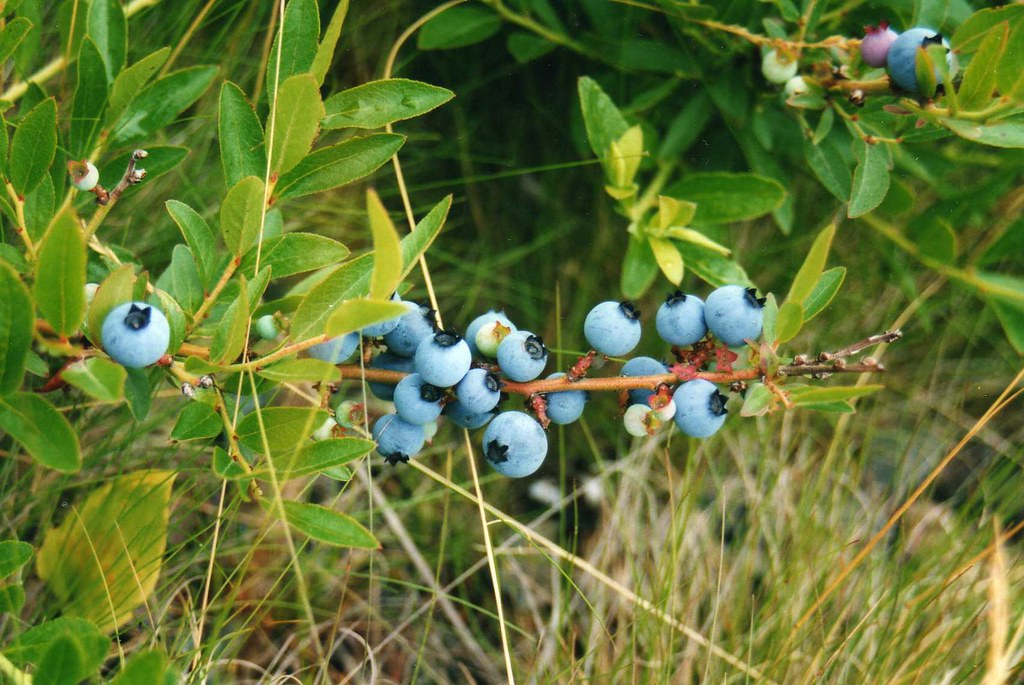
Vaccinium angustifolium
Milkweed
Asclepias, are classic American wildflowers that make a lovely addition to gardens. American milkweeds are an important nectar source for native bees, wasps, and other nectar-seeking insects, though non-native honey bees commonly get trapped in the stigmatic slits and die. Milkweed plants are the ONLY food that the larvae of the Monarch butterfly can eat, and thus they are the critical link in the lifecycle of the Monarchs. Without milkweeds, these beautiful butterflies will completely disappear.
Moss Varieties
Mosses are small flowerless plants that typically form dense green clumps or mats, often in damp or shady locations. Considered by botanists some of the oldest plants, some mosses date back 450 million years. That’s 50 million years before vascular plants like ferns appeared on Planet Earth. Their unique characteristics allow them to withstand extremes of climate change.

Northern Bayberry
Bayberry is an indigenous plant along the northern part of the eastern seaboard in the U.S.; its range also extends into Canada. They need full sun but don’t care about the soil they are in, as long as it well-drained. In the winter, they are known for their gray berries. While not a preferred food source for most birds, they do sere as an emergency food source. They do however provide wild birds some cover in winter.

Morella pennsylvatica
Pasture Rose
Rose hips develop on wild roses as the flowers drop off. The rosehip, also called the rose haw, is actually the fruit of the rose. These fruits are one of the most concentrated sources of vitamin C available. The fruit, known as rosehips, appears in early summer, ripening throughout the season and into autumn.
Rose hips have a tart flavor and can be used to make jelly, jam, soup or oil, or can be alternatively used to flavor tea. During World War II, the British government used collected rose hips to make rose hip syrup as a source of vitamin C to replace citrus fruits that were impossible to get.
Rosa carolina
Pennsylvania Sedge
The Pennsylvania Sedge is a low growing, semi-evergreen, perennial grasslike plant.
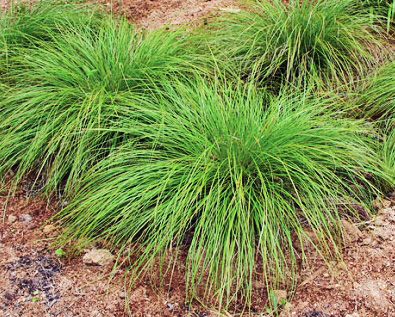
Carex pensylvanica
Pinelands Savannah
Our savannah is a mixed woodland-grassland ecosystem characterized by the trees being widely spaced so that the canopy does not close. The open canopy allows sufficient light to reach the ground to support an unbroken herbaceous layer consisting primarily of grasses and mosses.
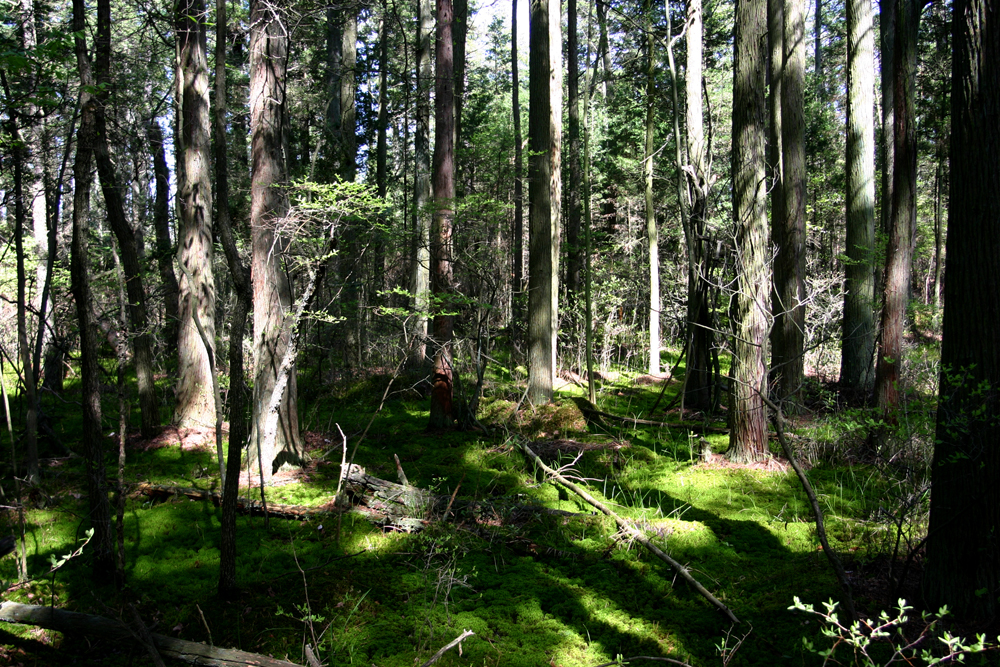
Pink Lady's Slipper a/k/a "wild orchid"
Cypripedium acaule, commonly called Pink Lady’s Slipper or Moccasin Flower, is widely distributed across the eastern United States and eastern to central Canada, from Alabama to the Northwest Territories. It is a large, showy wildflower belonging to the orchid family. It has two opposite basal leaves with conspicuous parallel veins and a large flower at the end of an erect stalk. The flower is magenta to whitish-pink; sometimes the whitish-pink flowers will have darker pink venation. Rarely the flower may be all white. This plant grows 6 to 15 inches tall and flowers generally between May and July. Pink lady’s slipper lives in a variety of habitats, growing in mixed hardwood coniferous forests of pine and hemlock on rocky/mossy slopes, and in semi-open or in deep humus and acidic but well-drained soil under birch and other deciduous trees of eastern United States forests.
The root of the lady’s slipper was used as a remedy for nervousness, tooth pain, and muscle spasms. In the 1800s and 1900s it, and other orchids, were widely used as a substitute for the European plant valerian for sedative properties.
In order to survive and reproduce, the pink lady’s slipper interacts with a fungus in the soil. Generally, orchid seeds do not have food supplies inside them like most other kinds of seeds. Pink lady’s slipper seeds require threads of the fungus to break open the seed and attach them to it. The fungus will pass on food and nutrients to the pink lady’s slipper seed. Pink lady’s slippers also require bees for pollination.
Pink lady’s slipper takes many years to go from seed to mature plants. Seed-bearing harvest of wild lady’s slipper root is not considered sustainable. Pink lady’s slippers can live to be twenty years old or more.
Rock Shelter for Small Animals and Reptiles
Just like birds use birdhouses for shelter, small animals and bugs can use logs and rocks for shelter. The shelter provides a place to raise young, hide from predators, and stay safe from the elements. Stones with depressions that collect water will provide drinking water.

Sassafras
Sassafras is a widespread tree and grows all over the eastern U.S. It is distinguished by its aromatic properties, which have made the tree useful to humans. Sassafras trees grow from 30–115 feet tall with many slender branches, and smooth, orange-brown or yellow bark. All parts of the plants are fragrant. The species are unusual in having three distinct leaf patterns on the same plant. Sassafras leaves are either oval (with no lobes), mitten-shaped (with two lobes) or dinosaur foot-shaped (with three lobes). You might find all three leaf shapes growing on a single slender branch. Sassafras is a traditional ingredient in real root beer.
The trees have striking fall color. The leaves will turn bright golden yellow, deep red and brilliant purple.
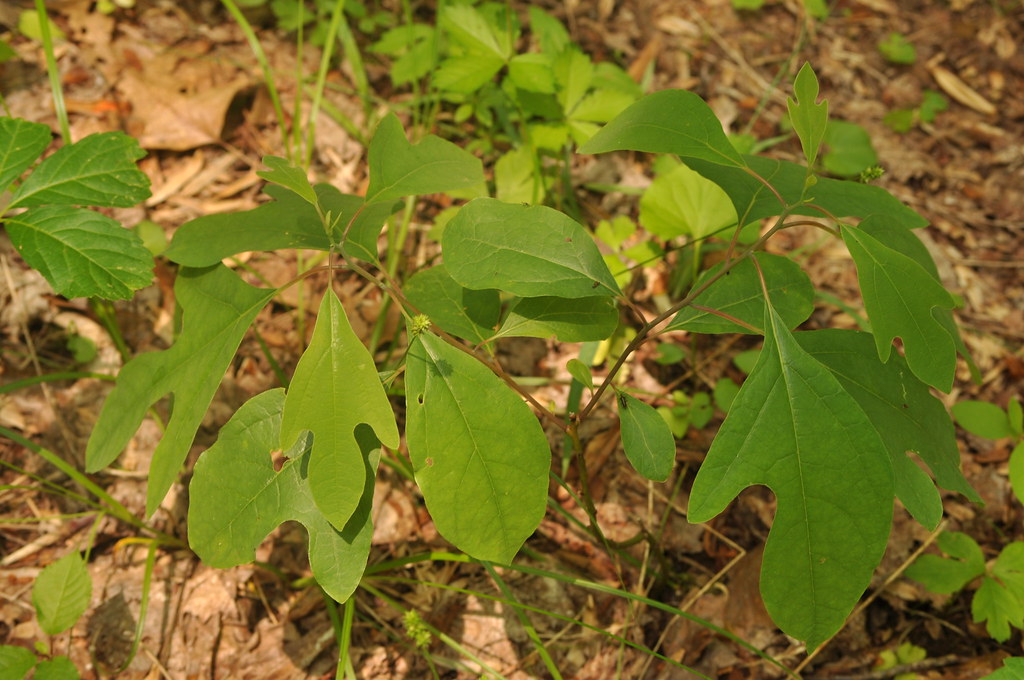
Sassafras albidum
Spagnem Moss
Sphagnum moss is a delicate system of capillary tubes allows the moss to absorb water like a sponge. They sometimes grows in small patches, but are generally found growing in a thick, dense clump. Sphagnum moss grows so close that it forms a cushiony “bog mat” that floats on top of the water; the mat is so strong that it can support the weight of several large moose. It’s roots are also very shallow. It is found in wet and boggy areas, and likes acidic (low pH) soil, so it is generally not found growing in the woods or in water that contains lime.
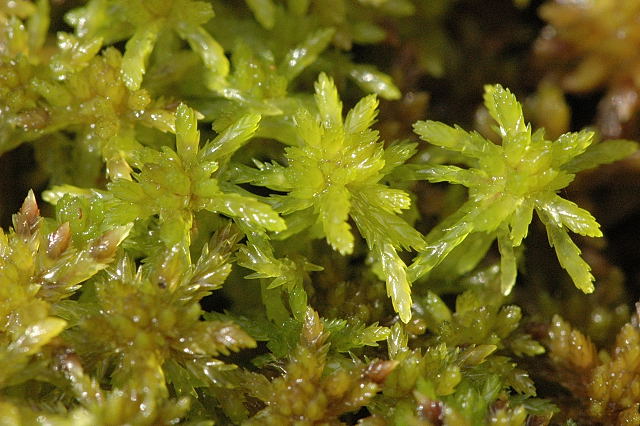
Sphagnum
Swamp Rose-Mallow
The common marshmallow plant is a green perennial that grows large, bee-pollinated, white flowers from July to September, followed by seedpods that ripen from August to October. The plant is hardy in U.S. Agriculture Department hardiness zones 3 through 9, where it grows wild in sunny but cool places on the edges of marshland and on grassy banks along lakes and other bodies of water.
Tulip Tree
Tuliptree is a large, fast-growing, flowering, wildlife-friendly deciduous (leaf shedding) tree. Yellow-and-orange bicolor flowers blooming May-June are valued by bees, butterflies, and hummingbirds. Flowers lead to ornamental, cone-shaped fruits bearing numerous winged seeds. Large, tulip-shaped leaves give this tree its common name. It is favored by wildlife for nest sites, cover, and food. Tuliptree is a host plant for butterfly and moth larvae (caterpillars).

Liriodendron tulipifera
Virginia Pine
Pinus Virginiana, an evergreen conifer, is native to the Eastern United States on either side of the Appalachian Mountains. Pinus Virginiana has a variety of names that include Scrub Pine, its most common alternative name, Poverty Pine, because it can grow in terrains that most other plants cannot grow in, or Jersey Pine because its northern natural limit of growth is in both New Jersey and Southern New York. It can grow on inhospitable soil, such as soils with acidic or neutral pH levels. When in urban environments its growth is reduced, but if found out in nature it can grow to be 40 feet in height and 30 feet in width. It is a member of the pine family. When at a size that can be used, Pinus Virginiana can be used as firewood, lumber, or even Christmas trees. It is susceptible to diseases and pests that plague other pines.
White Oak
The white oak is a large tree that grows to a height of 100 ft. The trunk is typically 2 to 4 feet in diameter. Grown trees in open areas have widely spread, rigid, horizontal branches that form a broad, round-topped crown. White Oak is a large, wildlife-friendly, deciduous (leaf shedding) tree. It’s greenish-yellow flowers bloom in April. It tolerates occasional flooding and drought and has medium-high wind resistance. Acorns provide a valuable food source for birds and wildlife. White Oaks is host to numerous, inconspicuous insects, which in turn provide food for birds. It is a host plant for butterfly and moth larvae (caterpillars). White Oak provides nesting space, cover, and shelter for wildlife.

Quercus alba
White Pine
The white pine, often used as a Christmas tree, is a hardy tree. It has clustered soft blue-green needles. Eastern white pine forests originally covered much of north-central and north-eastern North America. Only one percent of the old-growth forests remain after the extensive logging operations of the 18th century to the early 20th century.

Pinus strobus
Winter Berry Holly
The winterberry, is a species of holly native to eastern North America in the United States and southeast Canada, from Newfoundland west to Ontario and Minnesota, and south to Alabama.
The leaves are not shaped with sharp teeth like other hollies and are not evergreen. The purplish-green foliage turns black with the first frost. In late fall, the inconspicuous flowers are followed by dense clusters of bright red berries that remain on the branches throughout winter. Birds are highly attracted to them.
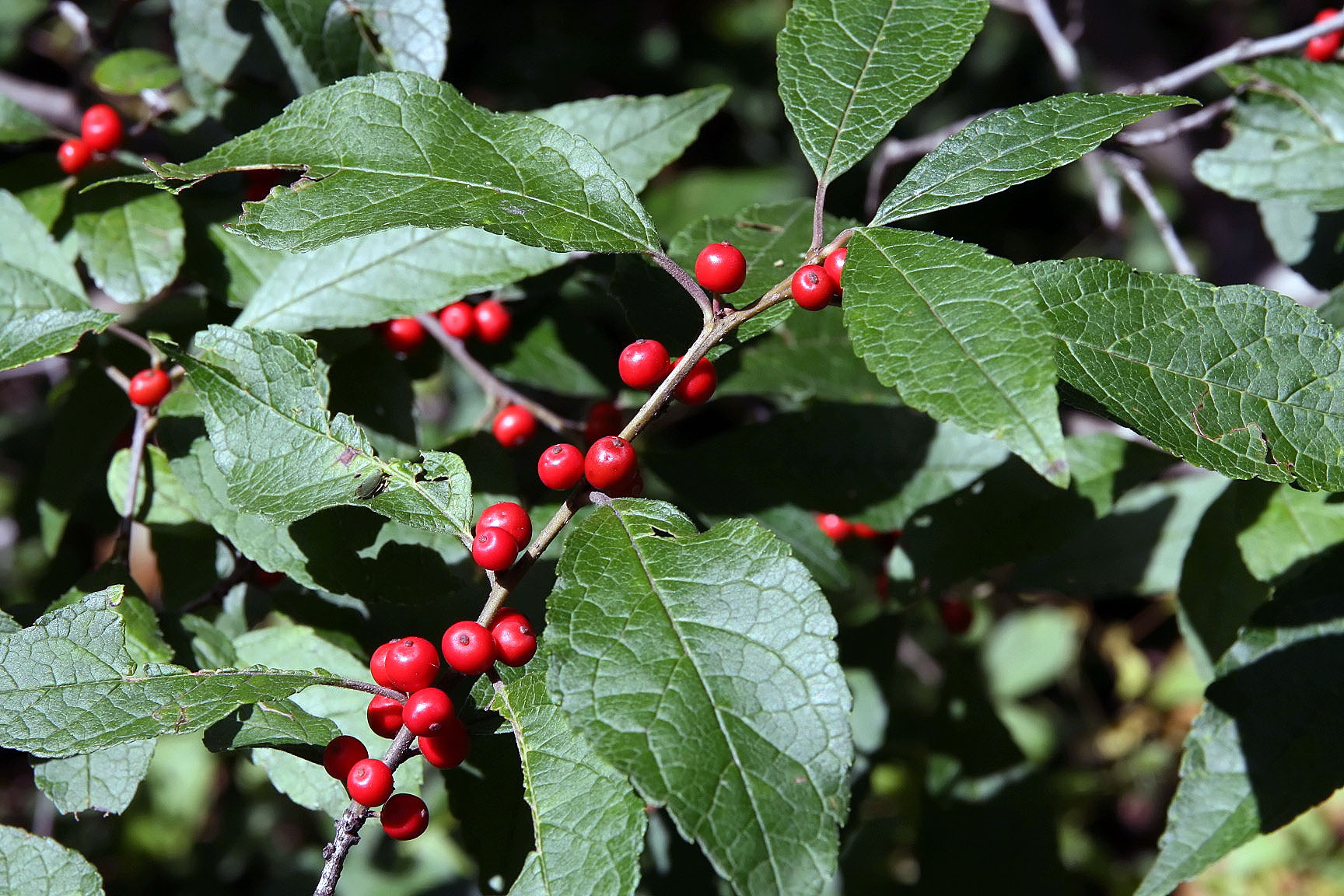
lex verticillata

